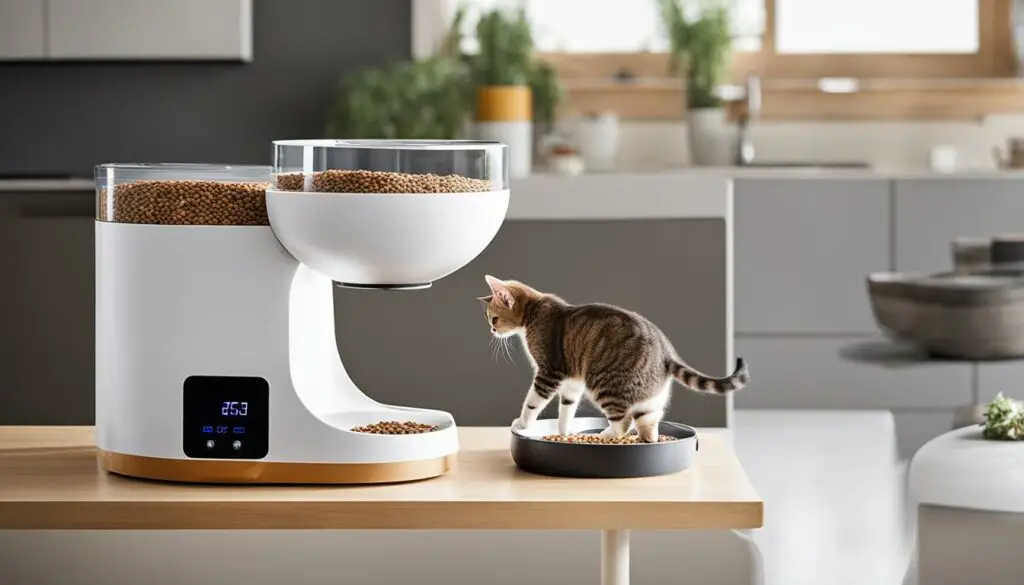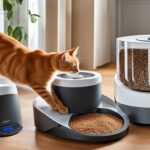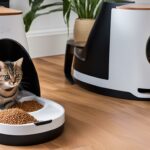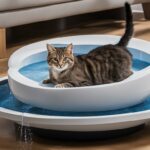As a cat parent, one of the concerns we often have is how long we can leave our feline friends alone when using an automatic feeder. We want to ensure their comfort and well-being during our absence. In this article, we will explore the factors that determine the ideal duration for leaving cats alone with an automatic feeder.
Key Takeaways:
- Consider the bond between cats and their humans when determining the ideal duration for leaving them alone.
- An automatic feeder and water fountain play a crucial role in a cat’s day-to-day life when their humans are away.
- For short trips, the automatic feeder and water fountain can adequately meet a cat’s physical needs, but emotional well-being should also be considered.
- Arranging for a reliable pet sitter is recommended for longer absences to ensure human interaction and monitoring.
- Using pet cameras and spending quality time with your cat are important for their security and reassurance when you’re away.
The Bond between Cats and Their Humans
Cats may be known for their independence, but they still form strong bonds with their humans. This bond is built on mutual trust, affection, and a shared daily routine, including feeding time. Understanding the significance of this bond is crucial in ensuring the well-being of our feline companions, especially when leaving them alone with an automatic feeder.
Feeding plays a vital role in the bond between cats and their humans. It provides an opportunity for interaction, companionship, and the establishment of a routine that cats rely on for comfort and security. When we leave our cats alone for extended periods, the absence of human presence during their feeding time can cause them distress.
While an automatic feeder helps maintain a consistent feeding schedule, it is essential to remember that cats also desire social interaction and companionship. Without human presence, cats may feel lonely, anxious, or even abandoned. It’s important to find ways to reassure them of our love and care even when we’re physically absent.
Understanding the bond between cats and their humans helps us recognize the potential distress that cats may experience when left alone for extended periods.
Feeding Routine and Companionship
Cats are creatures of habit and thrive on routines. Their feeding routine not only provides them with nourishment but also creates a sense of security and predictability in their daily lives. When we leave them alone with an automatic feeder, we must ensure that their feeding routine remains intact to maintain their emotional well-being.
Additionally, the bond between cats and their humans extends beyond mealtime. Cats seek affection, playtime, and human interaction throughout the day. When we’re absent, it’s important to find ways to address their need for companionship, whether through the use of pet cameras or arranging for a trusted sitter who can provide social interaction and playtime.
The bond between cats and their humans is a special connection that should be nurtured and maintained even when we’re not physically present. By taking the necessary steps to ensure their emotional well-being and providing them with the love and care they deserve, we can strengthen the bond and create a harmonious environment for our feline friends.
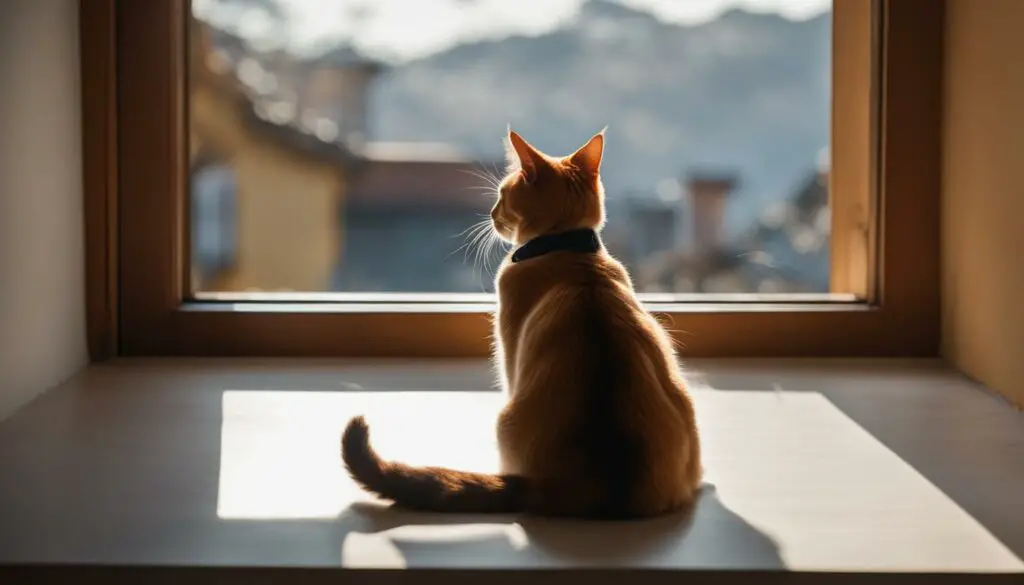
Day-to-Day Life with an Automatic Feeder and Water Fountain
When you’re away from home, an automatic feeder and water fountain ensure that your cat’s basic needs are met. The automatic feeder dispenses small portions of food at regular intervals, maintaining a consistent feeding schedule for your feline friend. This not only provides them with essential nourishment but also helps establish a sense of routine and security.
The continuous flow of water from the fountain entices your cat to drink more, promoting hydration and supporting their urinary health. Cats are naturally inclined to drink running water, and the water fountain mimics this preference, encouraging them to consume adequate amounts of water throughout the day.
By incorporating an automatic feeder and water fountain into your cat’s day-to-day life, you can ensure that they are well-fed and hydrated even when you’re not at home to supervise. These devices provide convenience and peace of mind, while also supporting your cat’s overall health and well-being.
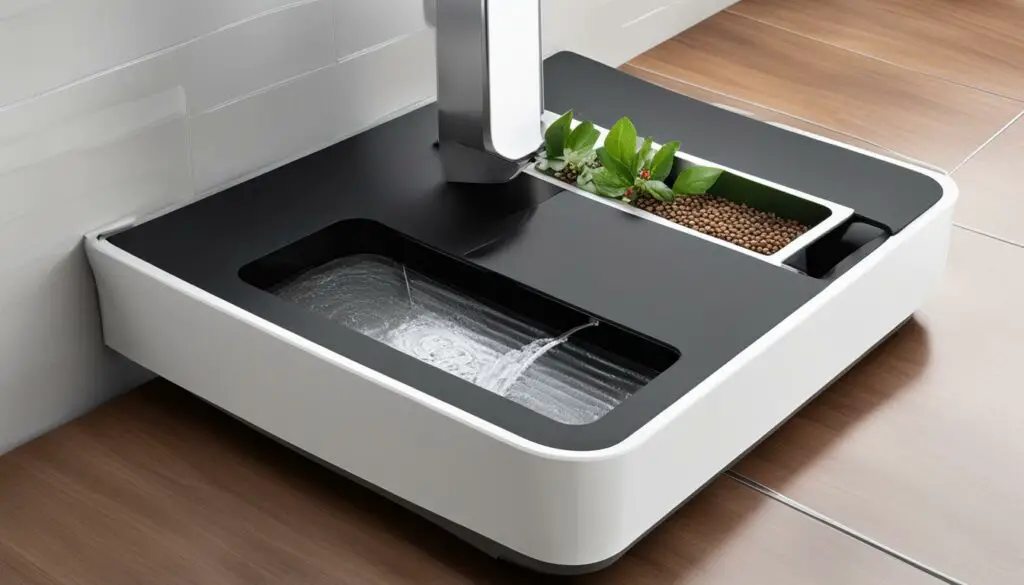
Benefits of an Automatic Feeder and Water Fountain
- Consistent feeding schedule
- Promotes hydration and urinary health
- Convenient and stress-free
- Ensures your cat’s well-being when you’re away
Having an automatic feeder and water fountain in your home not only ensures that your cat is well taken care of in your absence but also saves time and effort in maintaining their feeding routine. These devices provide a reliable solution for busy cat owners who want to ensure their feline companions receive proper nourishment and hydration even when they’re not physically present.
With an automatic feeder and water fountain, you can have peace of mind knowing that your cat’s dietary and hydration needs are being met consistently, promoting their overall health and happiness.
Short Trips Away from Home
When going on short trips that last a few days, an automatic feeder for cats can adequately meet their physical needs. The feeder ensures a consistent feeding schedule by dispensing small portions of food at set intervals. This helps to maintain their regular eating routine and ensures they receive the nourishment they need even when their humans are away.
However, it is essential to consider their emotional well-being as well. Cats are social creatures and may feel lonely or bored when left alone for extended periods. To ensure their overall happiness and entertainment, it is recommended to have a pet sitter or someone who can provide social interaction and playtime for the cat during these short trips.
By having a pet sitter or someone to engage with the cat, you can help alleviate any potential stress or anxiety they may experience from being alone. This interaction provides stimulation and keeps them entertained, which contributes to their overall well-being.
| Short Trips Away from Home | Considerations |
|---|---|
| Automatic Feeder for Cats | Ensures a consistent feeding schedule |
| Entertainment | A pet sitter provides social interaction and playtime for the cat |
| Pet Sitter | Alleviates potential stress and anxiety by providing companionship |
Maintaining a balance between meeting their physical needs and ensuring their emotional well-being is crucial when leaving a cat alone for short trips. By providing them with the care, attention, and entertainment they need, you can ensure that they are happy and comfortable in your absence.
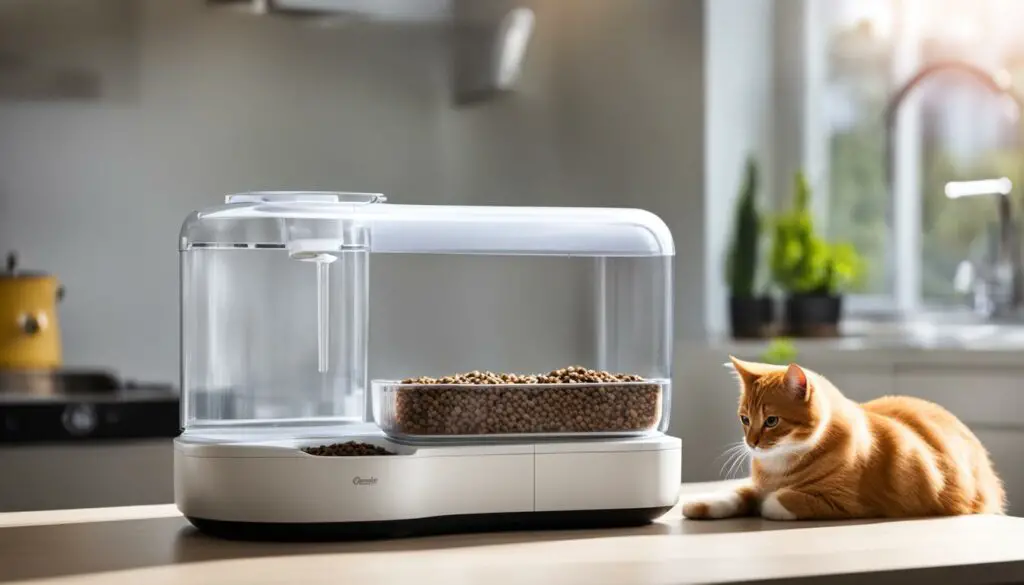
Entertainment and Playtime
During short trips away from home, it is important to keep your cat entertained and mentally stimulated. Leaving them with interactive toys, scratching posts, and hiding spots can help mimic their natural hunting instincts and provide them with hours of enjoyment. Additionally, engaging in playtime sessions with your cat before leaving can help tire them out and make them more content during your absence.
“Leaving a cat alone for short trips requires a balance of meeting their physical needs and ensuring their emotional well-being.” – Dr. Sarah Johnson
While an automatic feeder can take care of their feeding requirements, a pet sitter can offer the necessary human interaction and companionship that cats crave. A pet sitter can spend time playing, petting, and talking to your cat, ensuring they feel loved and cared for. This personal touch can make a significant difference in keeping your cat happy and comfortable, even when you’re not there.
Long Absences and Essential Preparations
When planning for long absences, such as vacations or business trips, it is crucial to make necessary preparations to ensure the well-being of your cat. While automatic feeders and water fountains can cover the basics of sustenance, additional measures are required to address their emotional and social needs.
Arranging for a Reliable Pet Sitter
To provide adequate care and monitoring for your cat during your absence, it is advisable to enlist the services of a reliable pet sitter. A pet sitter can not only check on your cat regularly but also provide essential social interaction and companionship. They can ensure that the automatic feeder and water fountain are functioning properly and monitor your cat’s overall health and well-being.
Ensuring Proper Monitoring and Communication
While you are away, it is important to stay connected with your pet sitter and have a system in place for regular communication and updates. Consider using pet monitoring systems or cameras to remotely check on your cat and interact with them. This not only provides peace of mind but also allows you to reassure your cat of your affection and presence, even when you’re not physically there.
Addressing Potential Health Concerns
Before leaving, ensure that your cat is in good health and up to date with veterinary appointments. Discuss any specific concerns or instructions with your pet sitter to ensure your cat’s well-being. It is also important to leave behind all necessary contact information for your veterinarian, in case any unexpected health issues arise during your absence.
Leaving a cat alone with an automatic feeder and water fountain for extended periods requires careful planning and consideration. By arranging for a reliable pet sitter, ensuring proper monitoring and communication, and addressing potential health concerns, you can ensure that your furry friend stays healthy, happy, and well-cared for, even in your absence.
| Preparations for Long Absences | Benefits |
|---|---|
| Arranging for a reliable pet sitter | Regular checks, social interaction, monitoring |
| Ensuring proper monitoring and communication | Peace of mind, remote interaction, reassurance |
| Addressing potential health concerns | Preventive care, access to veterinary support |
Love and Care for Your Cat, Even in the Absence
Leaving our cats alone can be a source of worry for many pet parents. We want to ensure their well-being and happiness, even when we’re not there to provide direct care. That’s why incorporating pet cameras into our cat care routine can greatly enhance our ability to monitor and interact with our furry friends while we’re away.
Pet cameras allow us to keep an eye on our cats, providing reassurance that they are safe and secure. With real-time video streaming, we can check in on them throughout the day, observing their behavior and ensuring they are comfortable. Seeing our cats in their familiar surroundings can bring peace of mind and a sense of connection, even when we’re physically apart.
“A pet camera can be a great way to monitor and interact with cats while away.”
But pet cameras are not just for monitoring. They also provide opportunities for interactive play and engagement. Many pet cameras feature built-in laser pointers or treat dispensers that can be controlled remotely. By engaging our cats in play or rewarding them with treats through the camera, we can provide mental stimulation and keep them entertained during our absence.
While pet cameras can be a valuable tool for maintaining cat well-being, it’s important to remember that they are not a substitute for human interaction. Upon returning home, spending quality time with our cats, offering physical affection, and reassurance of our love is essential. This helps reinforce the bond between us and ensures our cats feel secure and cared for, even when we’re not by their side.
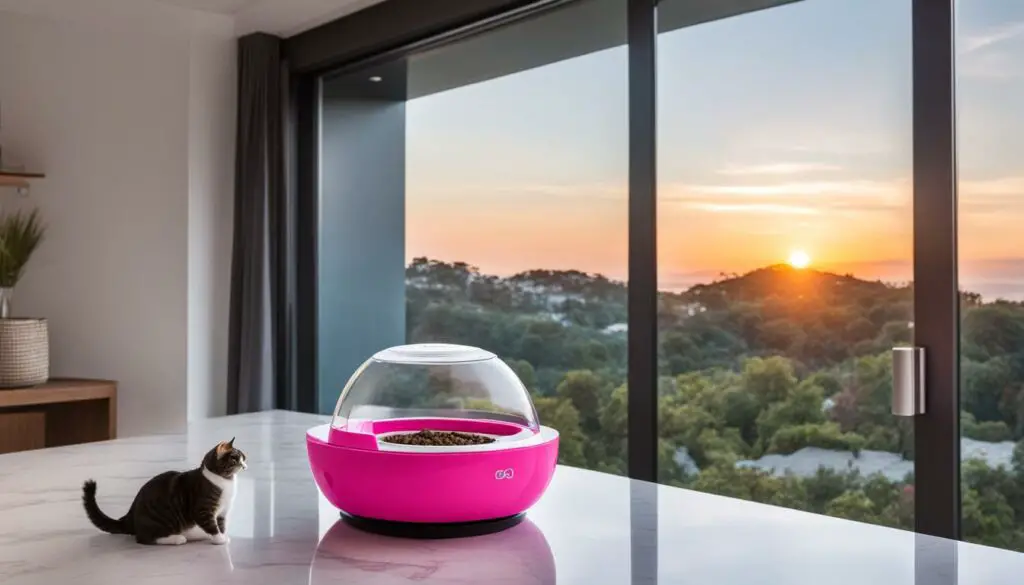
Image: pet cameras
Embracing Your Cat’s Individuality
When it comes to our furry friends, cats have their own unique personalities and individual needs. Understanding and embracing these individual traits is crucial for ensuring their comfort and well-being, especially when leaving them alone with an automatic feeder. Each cat has its own preferences, routines, and comfort levels, which should be taken into account when determining how long they can be left alone.
Cat comfort is a top priority when considering their alone time. Some cats may be perfectly content being left alone for longer periods, while others may quickly become anxious or stressed. Factors such as age, health conditions, and their familiarity with human presence can all influence their need for care and interaction. It is essential to tailor their alone time to cater to their specific needs and comfort levels.
Cat routine plays a significant role in their overall well-being. Cats thrive on routine and predictability, so maintaining consistency in their feeding, play, and sleep schedules is important. When planning for their alone time, it is helpful to stick as closely as possible to their regular routine. This can provide a sense of security and help alleviate any potential anxiety or stress they may experience.
| Factors to Consider for Cat’s Alone Time | ||
|---|---|---|
| Age | Health Conditions | Familiarity with Human Presence |
| Cat Comfort | Cat Routine |
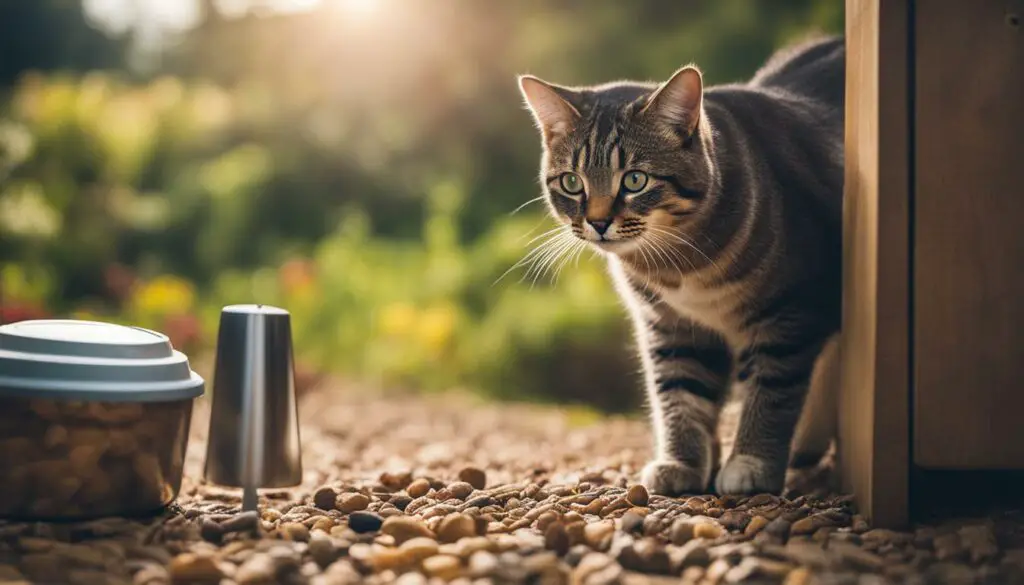
Understanding Your Cat’s Personality
Knowing your cat’s personality can be incredibly helpful in determining how long they can be left alone. Some cats are more independent and may thrive with longer periods of alone time, while others may be more social and crave more human interaction. Observing your cat’s behavior, preferences, and reactions to different situations can provide valuable insights into their personality and help you make informed decisions about their alone time.
Remember, every cat is unique, and what works for one may not work for another. By embracing and catering to your cat’s individuality, you can ensure that their alone time is as comfortable and stress-free as possible.
Safeguarding Your Furry Friend’s Haven
When leaving your beloved cat alone with an automatic feeder, ensuring their safety and comfort is of utmost importance. Cats can be curious and mischievous, so it’s crucial to identify and eliminate any potential hazards in their environment before you depart. Here are some key steps to safeguard your furry friend’s haven:
Create a Cat-Friendly Space:
Designate a safe area for your cat to retreat to while you’re away. This could be a cozy corner with their bed, toys, and scratching post. Ensure that there are no dangerous objects or substances within their reach, such as toxic plants, cleaning agents, or small items they could swallow.
Secure Electrical Cords:
Cats are naturally drawn to chew on things, including electrical cords. To prevent accidents and potential electrocution, secure your cords using cord covers, tape them to baseboards, or place them out of your cat’s reach. This simple precaution will give you peace of mind knowing your cat is safe from electrical hazards.
Store Hazardous Materials:
Keep potentially hazardous items like medications, chemicals, and cleaning products in secure cabinets or high shelves. Cats are agile and curious, so it’s important to prevent their access to these substances to avoid accidental poisoning or ingestion.
Eliminate Escape Routes:
Ensure that doors, windows, and other potential escape routes are securely closed and sealed. Cats are adept at finding small openings and may attempt to explore the outdoors in your absence. By eliminating escape routes, you can maintain your cat’s safety and prevent them from getting lost or injured.
By taking these precautions and providing a secure environment for your cat, you can leave them alone with an automatic feeder knowing that their well-being is prioritized. Remember, a safe and comfortable haven will ease any anxiety or stress your furry friend may experience while you’re away.
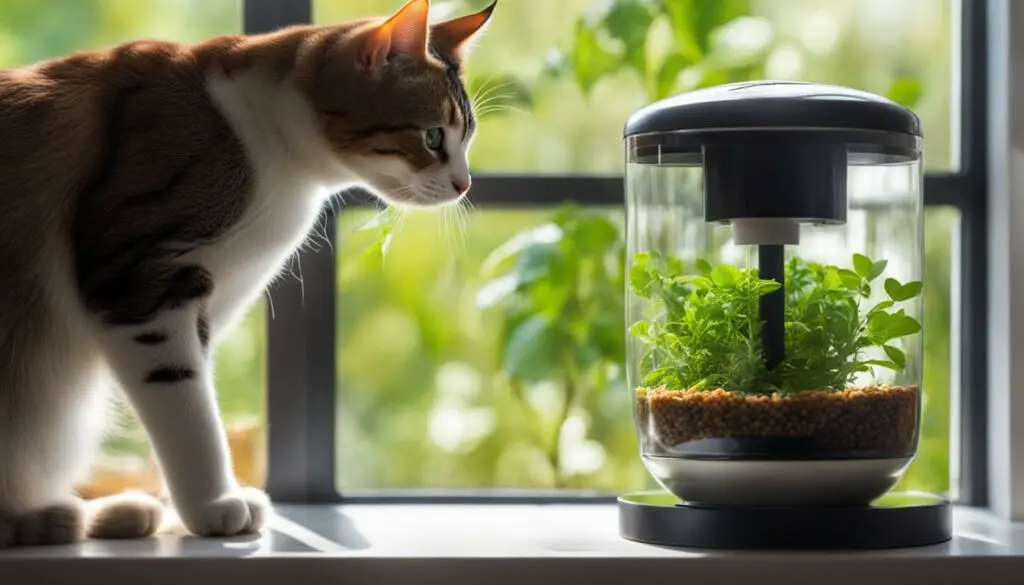
| Potential Hazards | Safety Measures |
|---|---|
| Toxic plants | Remove or place out of reach |
| Cleaning agents and chemicals | Secure in cabinets or high shelves |
| Electrical cords | Secure with cord covers or tape |
| Medications | Store in secure cabinets |
| Open doors and windows | Close and seal securely |
How Old Is Your Cat?
Understanding your cat’s age is essential for determining their nutritional needs, feeding frequency, growth mode, and metabolism. Cats go through different life stages, each with specific requirements to support their health and well-being. Let’s explore how age plays a crucial role in ensuring your cat receives the right care and nourishment.
Kitten Stage (0-6 Months)
Kittens are in a rapid growth phase and require a higher calorie intake compared to adult cats. Their nutritional needs should consist of a balanced diet that supports proper development. Feeding frequency for kittens is typically around four meals a day, gradually transitioning to three meals as they approach six months old. Providing a diet rich in essential nutrients, such as protein and calcium, is vital for their bone and muscle growth.
Adult Stage (7 Months – 10 Years)
During the adult stage, cats require a consistent feeding routine to maintain their health and ideal body weight. Most adult cats thrive on two meals a day, but individual preferences and activity levels may vary. It’s important to choose a balanced diet that meets their specific nutritional needs and supports their energy requirements. Regular monitoring of their body condition score helps ensure they maintain a healthy weight.
Senior Stage (10 Years and Older)
As cats enter their senior years, their metabolism and activity levels may decrease. A gradual transition to a diet formulated for senior cats can help address age-related changes and support their overall well-being. Senior cats may benefit from fewer but larger meals to accommodate their reduced appetite and potential dental issues. Regular check-ups with a veterinarian can help identify any health conditions that may require dietary adjustments.
| Life Stage | Nutritional Needs | Feeding Frequency |
|---|---|---|
| Kitten (0-6 months) | High calorie intake for growth and development | 4 meals a day, transitioning to 3 meals |
| Adult (7 months – 10 years) | Balance diet for energy and maintenance | 2 meals a day |
| Senior (10 years and older) | Diet for age-related changes | Fewer but larger meals |
Understanding your cat’s age-specific nutritional needs and feeding frequencies helps ensure they receive the appropriate care and support for their growth and well-being. Consult with your veterinarian to determine the best diet and feeding routine for your cat based on their age and individual requirements.
How Active Is Your Cat?
Understanding your cat’s activity level is essential for determining their energy needs, managing portion control, and effectively maintaining their weight. Each cat has a unique level of activity, which can range from highly active to sedentary. By monitoring your cat’s activity level and adjusting their food portions accordingly, you can ensure they maintain a healthy weight and overall well-being.
Cats with high activity levels require more calories to fuel their energy expenditure. These cats may engage in frequent play sessions, explore their environment extensively, or exhibit more active behaviors. To meet their energy needs, it is important to provide them with an appropriate portion size that accounts for their increased calorie requirements.
On the other hand, less active cats have lower energy needs and may be prone to weight gain if overfed. These cats may spend most of their time sleeping or resting, with minimal activity throughout the day. Monitoring their body condition score and adjusting their food portions can help prevent obesity and associated health issues.
Table: Activity Levels and Portion Control
| Activity Level | Portion Control |
|---|---|
| Highly Active | Provide larger food portions to meet their increased energy needs. |
| Moderately Active | Offer balanced portions to maintain their energy levels without excessive weight gain. |
| Somewhat Active | Monitor their food intake and adjust portions as needed to prevent weight gain. |
| Sedentary | Provide smaller food portions and encourage moderate activity to prevent obesity. |
It is important to note that every cat is unique, and their activity level may change over time. Factors such as age, health conditions, and environmental enrichment can influence their energy needs. Regularly monitoring their weight, adjusting portion sizes as necessary, and consulting with a veterinarian can help you ensure that your cat’s nutritional needs are met and their weight is effectively managed.
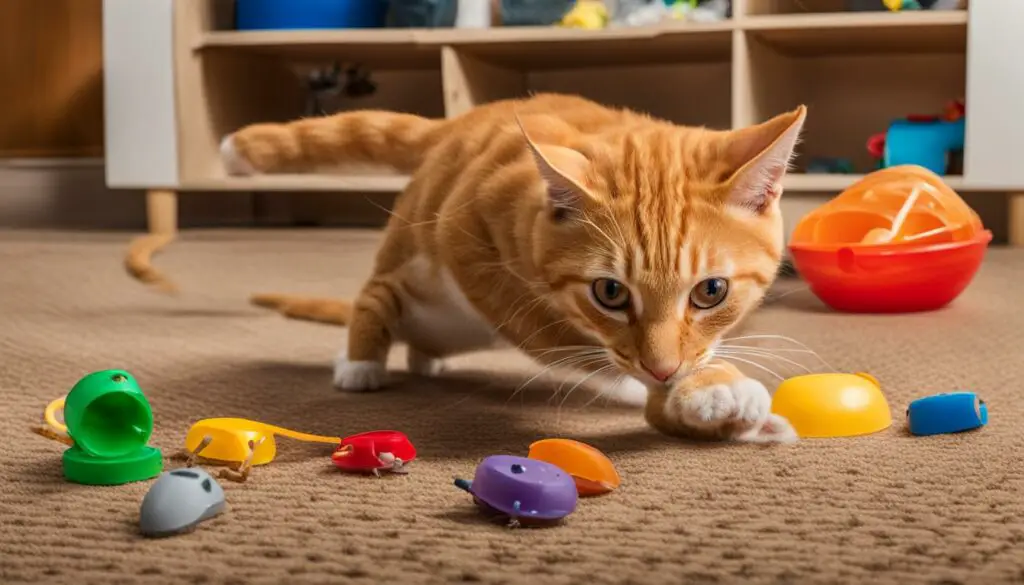
What Type of Food Does Your Cat Eat?
When it comes to leaving your cat alone with an automatic feeder, it’s essential to consider the type of food they eat. The choice between dry food and wet food can impact the freshness of the food and the compatibility with the automatic feeder.
Dry food, also known as kibble, is a popular choice for many cat owners. It is convenient, has a long shelf life, and can be left out for more extended periods. However, it’s important to note that the flavor and oils in dry food may diminish over time, leading to a potential decrease in palatability for some cats.
On the other hand, wet food offers higher moisture content, which can be beneficial for cats who need additional hydration. It is generally more appealing to cats due to its strong odor and rich taste. However, wet food has a shorter shelf life once opened and may not be suitable for some automatic feeders that dispense portions over an extended period.
Feeding Recommendations:
- If your cat primarily eats dry food, it’s crucial to choose an automatic feeder that can maintain the kibble’s freshness over an extended period. Look for feeders with airtight seals or those that have separate compartments to keep the remaining food protected.
- For cats who prefer wet food, you may need to consider alternative feeding options when using an automatic feeder. One option is to use single-serve pouches or cans that can be easily placed in the feeder for each meal. Another option is to have a pet sitter or a timed release feeder that can dispense fresh wet food at specified times.
Understanding your cat’s food preferences and choosing a suitable automatic feeder can help ensure that your feline friend receives fresh and appetizing meals even when you are not at home.

How Long Will You Be Gone?
When planning to leave your cat alone, it is important to consider the duration of your absence. The length of time you will be away plays a crucial role in determining the most suitable pet care solutions for your feline friend. Whether it’s a short trip or an extended vacation, making the right arrangements ensures your cat’s well-being and comfort throughout your time away.
If your absence will only be for a few days, an automatic feeder and water fountain can adequately meet your cat’s physical needs. These devices will ensure that your cat has access to food and water at regular intervals, promoting a consistent feeding routine. However, it’s also important to consider your cat’s emotional well-being during this time. If your trip extends beyond a couple of days, it may be beneficial to have a pet sitter or someone who can provide social interaction and entertainment for your cat.
For longer absences, such as vacations or business trips, additional arrangements need to be made to ensure your cat’s overall well-being. While the automatic feeder and water fountain can cover the basics of sustenance, it is advisable to have a reliable pet sitter who can check on your cat, provide social interaction, and monitor their health. This ensures that your cat receives the care and attention they need in your absence. The presence of a trusted caregiver will give you peace of mind knowing that your cat is well taken care of and their needs are being met.
Remember, cats thrive on love and attention, even when we’re not physically present. There are various pet cameras available that allow you to monitor and interact with your cat remotely, providing them with reassurance and a sense of connection. Additionally, when you return, make sure to spend quality time with your cat and reassure them of your affection. This will help strengthen the bond between you and ensure that your cat feels secure and loved, even in your absence.
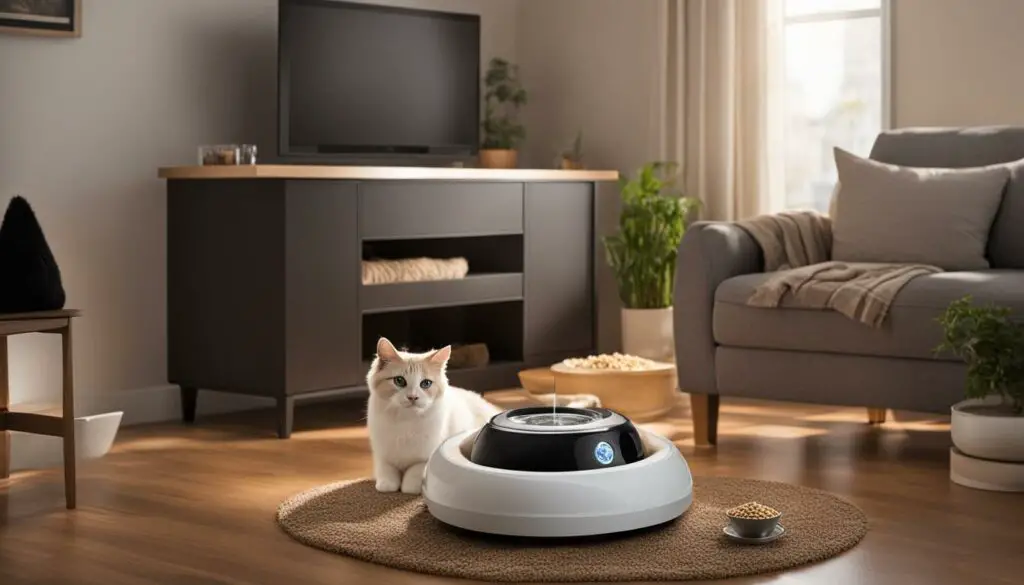
Table: Duration-Based Pet Care Solutions
| Duration | Pet Care Solutions |
|---|---|
| Short Trips (Up to a week) | Automatic feeder and water fountain |
| Extended Trips (Exceeding a week) | Pet sitter or caregiver for social interaction and monitoring |
Conclusion
Leaving cats alone with an automatic feeder requires careful consideration and responsible pet care. Understanding the individual needs of your feline friend and selecting the right feeder are crucial steps in ensuring their well-being. By prioritizing their comfort, health, and happiness, we can confidently leave them in the care of an automatic feeder.
However, it’s important to remember that an automatic feeder can only meet their basic physical needs. Social interaction, monitoring, and reassurance are still essential for their overall well-being. For longer absences, arranging for a reliable pet sitter who can provide companionship, check on your cat, and monitor their health is highly recommended.
Responsible pet care involves creating a safe environment for your cat, considering their age, activity level, and dietary preferences. By understanding their unique personality and needs, you can ensure that they are comfortable and content even in your absence. Remember, leaving cats alone with an automatic feeder is not just about providing sustenance, but also about keeping them happy and loved.
So, if you’re planning to leave your cat alone with an automatic feeder, take the time to make appropriate preparations. Consider their individual requirements, choose a high-quality feeder, and arrange for suitable care. By doing so, you can enjoy peace of mind knowing that your feline friend will be well-cared for while you’re away.
FAQ
How long can you leave a cat alone with an automatic feeder?
The duration depends on several factors, including your cat’s individual needs and the length of your absence. Short trips of a few days can be managed with an automatic feeder, but longer absences may require additional care from a pet sitter.
What is the importance of the bond between cats and their humans?
The bond between cats and their humans is vital for their overall well-being. It ensures companionship, routine, and emotional support. Recognizing the significance of this bond helps us understand the potential distress that cats may experience when left alone for extended periods.
How does an automatic feeder and water fountain benefit a cat’s day-to-day life?
An automatic feeder provides a consistent feeding schedule by dispensing small portions of food at set intervals. A water fountain promotes hydration, which is essential for kidney and urinary health. Together, they help meet a cat’s physical needs when their humans are away.
Can an automatic feeder and water fountain suffice for short trips?
Yes, for short trips lasting a few days, an automatic feeder and water fountain can adequately meet a cat’s physical needs. However, it is essential to consider their emotional well-being as well and ensure they receive social interaction and entertainment from a pet sitter or someone trusted.
What should I do for longer absences, such as vacations or business trips?
For longer absences, it is recommended to arrange for a reliable pet sitter. A pet sitter can check on your cat, provide social interaction, monitor the automatic feeder and water fountain, and ensure your cat’s overall health and well-being are maintained.
How can I monitor and interact with my cat while I’m away?
Pet cameras can be a great way to monitor and interact with your cat while you’re away. They allow you to see and talk to your cat remotely, providing reassurance and a sense of connection.
How does my cat’s age affect their need for care and comfort?
Each cat is unique, and their age plays a significant role in determining their nutritional needs and feeding frequency. Kittens and young cats require more frequent meals to support their growth and development, while senior cats may benefit from fewer but larger meals.
How can I ensure my cat’s safety when leaving them alone?
Before leaving, it is essential to identify and eliminate any potential hazards in your home that could harm your cat. Additionally, providing a safe and comfortable retreat for your cat helps minimize stress and anxiety.
What factors should I consider in determining the ideal feeding portions for my cat?
Your cat’s activity level directly affects their energy needs and the amount of food they require. Active cats may need more calories to maintain a healthy weight, while less active cats may require fewer calories to prevent weight gain. Adjusting the automatic feeder’s portions based on their activity level is important for their overall health.
How does the type of food my cat eats affect its freshness in an automatic feeder?
Dry kibble is more shelf-stable but may lose some flavor and oils over time. Wet food has a shorter shelf life once opened and is best-suited for feeders that can dispense all portions within a few days. Consider the type of food your cat eats when choosing an automatic feeder.
How do I choose the most suitable pet care solution based on the duration of my absence?
Short absences of up to a week can typically be managed with an automatic feeder. However, trips exceeding a week may require the assistance of a pet sitter or someone who can provide round-the-clock care and ensure your cat’s needs are met.
What should I keep in mind when leaving a cat alone with an automatic feeder?
Leaving a cat alone with an automatic feeder requires thorough preparation and consideration for their well-being. From understanding their individual needs to ensuring their safety and providing emotional support, responsible pet care is essential even when we’re away.

